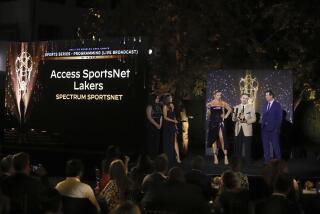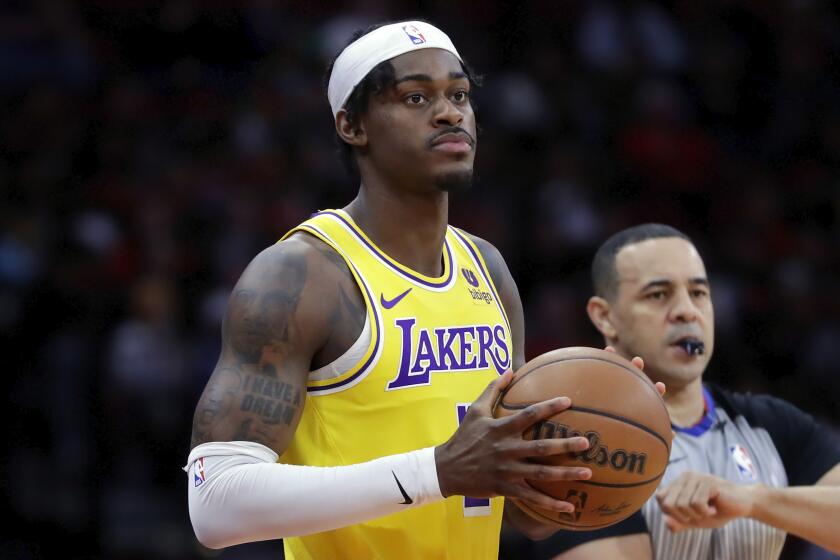His time on beat fades to black
- Share via
After today I’m moving full time to the horse racing beat. One might say I’m being put out to pasture. But I don’t see it that way. It’s a new chapter in my life, and I’m off and running.
I wrote my first column about sports on television and radio for the Los Angeles Herald Examiner in May 1973.
And, boy, how things have changed.
I found some old columns that brought back some memories. The lead item in my first column in 1973 was about a Lakers conference semifinal playoff game against the Chicago Bulls. That Bill Sharman-coached Lakers team beat the Bulls and Golden State Warriors to advance to the NBA Finals, where they lost to the New York Knicks, four games to one. The Knicks winning an NBA title. Yes, things have changed.
The Lakers-Bulls playoff game I wrote about was televised on two channels in Los Angeles. There was the local telecast on Channel 5, with Chick Hearn and Lynn Shackelford announcing, and the ABC network telecast on Channel 7, with Keith Jackson and Bill Russell.
The local telecast got the higher rating, 11 to 9. The interesting thing here is that 11 and 9 add up to 20, and hardly anything gets a 20 rating anymore. The highest-rated sporting event on TV in Los Angeles last weekend was the San Diego Chargers’ game against the Chicago Bears on Fox. It got an 11.5. NBC’s Sunday night game got a 9.7.
It’s a different era.
“People say to me today that college basketball games are getting only 1.2 ratings,” said Dick Enberg. “They’ll say, ‘That’s a far cry from what they got when you were doing college basketball with Al McGuire and Billy Packer.’ And I’ll say, ‘That’s because there are so many games on now. If you add up all the 1.2s, you’ll get what we did back then.’ ”
The amount of sports on television today is the biggest change. In 1973 there was no cable television, no ESPN, no FSN West or FSN Prime Ticket. There was no Fox Sports or sports talk radio. There was no TiVo. Shoot, there weren’t even VCRs. And television coverage was basically point a camera and shoot.
But things were changing, and a pioneer in that change was an old-timer, NBC director Harry Coyle. He directed the first 35 World Series, and was the first to use a center-field camera. He never stopped trying different things throughout his illustrious career. It was Coyle who kept a camera on the Boston Red Sox’s Carlton Fisk as he motioned his game-winning home run fair in Game 6 of the 1975 World Series.
“Harry Coyle did as much for televised baseball as anyone,” said longtime sports television producer Mike Weisman, who worked alongside Coyle for many years. “Harry’s coverage of baseball changed the way all sports were covered.”
Coyle died in 1996 at the age of 74, but his legacy lives on in the form of more technological advances in how games are covered.
“I’d say the biggest change I’ve seen is the technology,” said Vin Scully. “I think the equipment that allows producers and directors to do so many different things has helped revitalize baseball telecasts.”
Scully spent 20 years on network television, first doing football and golf for CBS, then baseball for NBC. He left NBC in 1989 after CBS acquired baseball’s television rights. Through all that, he continued to work for the Dodgers and is now in his 58th season with the team.
“I enjoyed my years at the networks but not once did I ever have a yearning to go back,” he said.
In digging through boxes and scrapbooks of clippings and letters, I found one of the many notes Scully sent through the mail over the years. This one was dated Jan. 26, 1978.
Scully’s words were in response to something I had written, and he concluded with: “Some big deal I am -- I read your column and I still have to put out the garbage.”
On the phone this week, he said, “My biggest concern is that you are happy.”
One thing I’ll be happy about is not dealing with the hundreds of press releases that fill my e-mail inbox every day. Sports television has become a huge business. When I started out on the beat, there were three networks televising sports. Now there are too many to count, including all those specialty channels -- the Golf Channel, the Tennis Channel, Speed and on and on.
In May 1979, I wrote a major piece for The Times about the future of sports on cable television. The main story focused on Ted Turner and the national telecasts of his Atlanta Braves on Superstation WTBS. I recall being told I had 10 minutes for an interview with Turner. I asked one question, and 30 minutes later he was still talking.
In doing the research for that story, someone -- I can’t remember who -- suggested I contact Stu Evey of Getty Oil. Getty was backing a project by a father and son, Bill and Scott Rasmussen, who had this idea of starting a 24-hour sports channel.
It was going to be based in Bristol, Conn., and called the Entertainment and Sports Programming Network, or ESPN for short. The word “entertainment” was included because the Ramussens didn’t think they could fill 24 hours with nothing but sports.
To be honest, neither did I. In fact, it sounded like a crazy idea. Anyway, I tracked down Scott Rasmussen and wrote a short story to accompany the cable piece.
Six months later, ESPN was launched. And it turned out to be not such a crazy idea after all.
ESPN’s success launched a new era for sports television. But some, such as legendary announcer Keith Jackson, believe the “glory days” of sports broadcasting are behind us.
“They ended around 1990,” he said. “We were building an industry. Then the suits came in.”
As is the case with much of corporate America, the bottom line -- and with television that means excessive self-promotion -- became the end all. And much of the fun part of the business, which includes writing about it, was never the same.
--
Christine Daniels’ Sound and Vision column takes this spot beginning next Friday.
More to Read
Go beyond the scoreboard
Get the latest on L.A.'s teams in the daily Sports Report newsletter.
You may occasionally receive promotional content from the Los Angeles Times.










